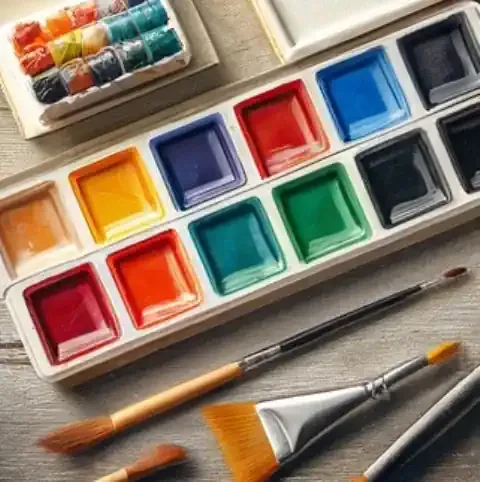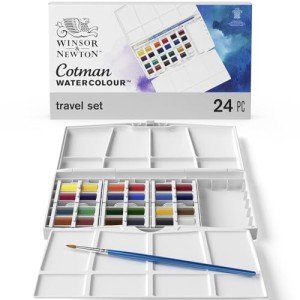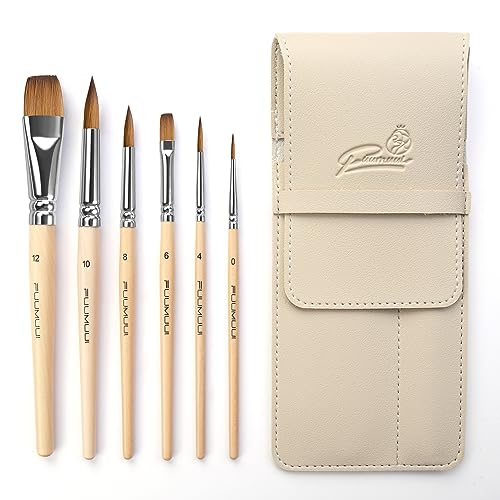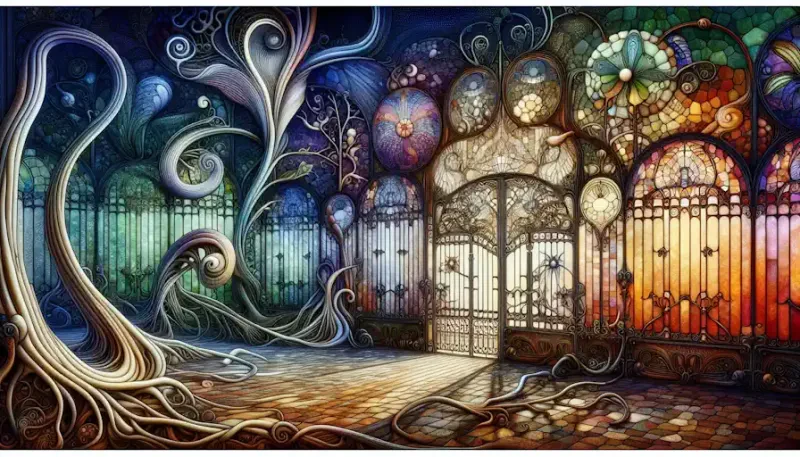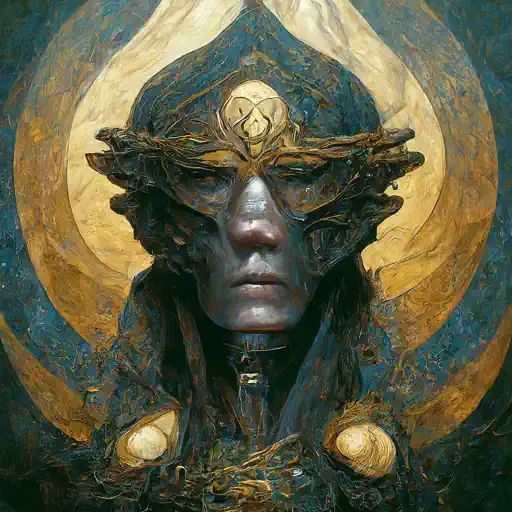Introduction
Watercolor painting is a captivating journey into the world of artistry, offering a unique blend of fluidity, vibrancy, and expressive potential. In this beginner's guide, we embark on an exploration of the enchanting medium of watercolors, uncovering its intricacies and unlocking the secrets to mastering this timeless art form.
Watercolor Paint Set - 36 Tubes & Brushes
Unleash Your Creativity with Our Premium Watercolor Paint Set and 36 High-Quality Brushes!
Product information
$37.95 $29.95
Product Review Score
4.23 out of 5 stars
73 reviewsProduct links
Capturing the Beauty of Watercolor
At its core, watercolor painting is about capturing the ethereal beauty of light, color, and movement. Unlike other mediums, watercolors possess a transparent quality that allows light to pass through layers of pigment, creating luminous and delicate effects that evoke a sense of enchantment. From the subtle washes of pastel hues to the bold strokes of vibrant color, watercolors possess a captivating allure that mesmerizes both artist and viewer alike.
Why Watercolor Painting?
The allure of watercolor painting lies in its versatility, spontaneity, and accessibility. Whether you're a seasoned artist or a complete novice, watercolors offer endless possibilities for creative expression. With their forgiving nature and quick drying time, watercolors encourage experimentation and exploration, allowing artists to embrace mistakes as opportunities for artistic discovery. Moreover, the portability of watercolor supplies makes it an ideal medium for artists on the go, enabling them to capture fleeting moments of inspiration wherever they may roam.
Overview of What to Expect
In the following sections, we'll delve into the fundamentals of watercolor painting, from understanding the different types of paints and materials to mastering essential techniques and exploring various subjects. Whether you're looking to create serene landscapes, captivating still lifes, or expressive portraits, this guide will equip you with the knowledge and skills needed to embark on your own watercolor journey. So grab your brushes, prepare your palette, and let's dive into the mesmerizing world of watercolor painting together.
Getting Started: Understanding Watercolor Basics
Before diving into the colorful world of watercolor painting, it's essential to familiarize yourself with the basic components and tools of the craft. In this section, we'll explore the foundational elements of watercolor painting, from understanding the different types of paints to acquiring the necessary tools and materials.
Exploring Watercolor Paints
Watercolor paints come in two primary forms: tubes and pans. Tubes contain concentrated pigment suspended in a water-soluble binder, offering vibrant colors and versatility. Pans, on the other hand, consist of dried cakes of paint that can be activated with water when needed. When choosing between tubes and pans, consider factors such as convenience, cost, and personal preference.
Quality vs. Price: Choosing the Right Paints
When selecting watercolor paints, quality should be a primary consideration. While student-grade paints are more affordable, they often contain less pigment and lower-quality binders, resulting in less vibrant colors and inferior lightfastness. Professional-grade paints, although more expensive, offer superior color intensity, lightfastness, and handling properties, making them a worthwhile investment for serious artists.
Necessary Tools and Materials
In addition to watercolor paints, several essential tools and materials are necessary for successful painting sessions. These include:
Brushes: Types and Sizes
Round brushes: Versatile and suitable for a variety of techniques, such as washes, detailing, and line work.
Flat brushes: Ideal for covering large areas and creating crisp edges.
Synthetic vs. natural hair brushes: Synthetic brushes are durable and retain their shape well, while natural hair brushes offer superior water retention and a softer touch.
Professional Sable Watercolor Brushes for Artists - 6pcs
Upgrade your painting experience with these 6pcs professional sable watercolor brushes ideal for artists
Product information
$19.89
Product Review Score
4.59 out of 5 stars
49 reviewsProduct links
Paper: Understanding Paper Weight and Texture
Watercolor paper comes in various weights and textures, with heavier weights (measured in pounds or grams per square meter) typically preferred for wet-on-wet techniques and washes.
Textures range from rough to hot-pressed, each offering unique surface characteristics that affect paint application and final results.
Other Essential Tools: Palette, Water Containers, and Masking Fluid
Palette: Used for mixing and diluting watercolor paints, palettes come in various materials, such as plastic, porcelain, or metal.
Water containers: Essential for rinsing brushes and diluting paints, water containers should be large enough to accommodate brushes and provide clean water for painting.
Masking fluid: A liquid latex compound used to preserve areas of white paper or previously painted layers, masking fluid allows artists to create crisp highlights and protect delicate details.
By familiarizing yourself with these basic tools and materials, you'll be well-equipped to embark on your watercolor painting journey with confidence and creativity.
Techniques and Tips for Beginners
Mastering watercolor painting requires not only an understanding of basic techniques but also practice and experimentation. In this section, we'll explore fundamental techniques and provide tips to help beginners develop their skills and confidence in using watercolors.
Color Mixing Fundamentals
Understanding color mixing is essential for achieving the desired hues and tones in your watercolor paintings. This begins with grasping basic color theory, which involves the interaction of primary colors (red, blue, and yellow) to create secondary colors (orange, green, and purple). By mastering color mixing, you can expand your palette and achieve a wide range of colors with just a few tubes of paint.
Basic Color Theory
Color theory encompasses principles such as the color wheel, color harmony, and complementary colors. Familiarizing yourself with these concepts will enhance your ability to create visually appealing compositions and achieve balance and unity in your artwork.
Mixing Primary Colors to Create Secondary Colors
Experiment with mixing primary colors to create secondary colors:
Red + yellow = orange
Yellow + blue = green
Blue + red = purple
Adjust the ratios of each primary color to achieve different shades and intensities of secondary colors.
Understanding Washes
Washes are foundational techniques in watercolor painting that involve applying diluted paint to the paper surface to create smooth, seamless color transitions. Two primary wash techniques are commonly used:
Wet-on-Wet Technique
Wet the paper with clean water before applying paint, allowing colors to blend and flow freely across the surface.
Ideal for creating soft edges and atmospheric effects.
Wet-on-Dry Technique
Apply paint to dry paper, allowing for sharper edges and more controlled color placement.
Suitable for adding details and defining specific areas of your composition.
Creating Depth and Texture
Achieve depth and texture in your watercolor paintings through layering techniques and the use of dry brushing and lifting:
Layering Techniques
Build up layers of transparent washes to create depth and dimension in your artwork.
Experiment with glazing to achieve rich, luminous colors and subtle variations.
Adding Details with Dry Brushing and Lifting
Dry brushing involves applying paint with a relatively dry brush to create texture and highlight details.
Lifting refers to the removal of wet or dry paint from the paper surface using a clean, damp brush or absorbent material, allowing for corrections and highlights.
Practice Exercises for Skill Development
Regular practice is key to improving your watercolor painting skills. Consider incorporating the following exercises into your practice routine:
Simple Shapes and Forms
Practice painting basic shapes such as circles, squares, and triangles to develop brush control and color mixing skills.
Graduated Washes and Blending
Experiment with creating smooth, graduated washes by varying the concentration of paint and water.
Practice blending colors together seamlessly to achieve subtle transitions and gradients.
By mastering these fundamental techniques and incorporating regular practice into your routine, you'll soon develop confidence and proficiency in using watercolors to bring your artistic vision to life.
Exploring Different Subjects
Watercolor painting offers endless possibilities for artistic expression across a wide range of subjects. In this section, we'll explore three popular subjects—landscapes, still life, and portraits—and discuss techniques for capturing their unique characteristics using watercolors.
Landscapes
Landscape painting allows artists to capture the beauty and tranquility of the natural world. Whether depicting sweeping vistas or intimate scenes, watercolors are well-suited for conveying the atmospheric effects and subtle nuances of landscapes.
Basic Landscape Elements
Sky: Experiment with blending various shades of blue and gray to create realistic skies, and use techniques like wet-on-wet and wet-on-dry to capture clouds and atmospheric effects.
Land: Use layers of transparent washes to depict rolling hills, rugged mountains, or lush valleys, paying attention to perspective and depth.
Water: Explore techniques such as glazing and dry brushing to render reflections and ripples on lakes, rivers, and oceans.
Techniques for Capturing Scenery
Use masking fluid to preserve highlights and intricate details such as trees, rocks, and architectural elements.
Experiment with different brushstrokes and textures to convey the varied surfaces and textures found in landscapes, from soft foliage to rough terrain.
Still Life
Still life painting involves arranging and composing inanimate objects to create compelling and visually engaging compositions. Watercolors are well-suited for capturing the delicate interplay of light and shadow in still life subjects.
Composition and Arrangement
Select objects with interesting shapes, textures, and colors, and arrange them in a balanced composition with consideration for negative space and focal points.
Experiment with different lighting setups to create dramatic effects and cast intriguing shadows.
Playing with Light and Shadows
Use transparent washes and glazes to build up subtle gradations of light and shadow, creating depth and volume in your still life compositions.
Pay attention to the direction and intensity of light, and observe how it interacts with different surfaces and materials.
Portraits
Portraiture is a challenging yet rewarding subject for watercolor painters, requiring careful observation and attention to detail. Capturing the likeness and personality of a subject with watercolors can be a deeply expressive and emotive process.
Capturing Facial Features with Watercolor
Start by sketching the basic proportions and features of the face using light pencil marks, then gradually build up layers of transparent washes to add color and definition.
Focus on capturing the subtle nuances of expression, such as the play of light on the skin and the sparkle in the eyes.
Adding Expressiveness to Portraits
Experiment with different brush techniques to convey mood and emotion in your portraits, from soft, blended strokes to bold, expressive lines.
Pay attention to color temperature and value to create realistic skin tones and convey the character and personality of your subject.
By exploring these diverse subjects and experimenting with different techniques and approaches, you'll expand your artistic repertoire and develop your own unique style as a watercolor painter.
Troubleshooting and Common Mistakes
Even experienced watercolor artists encounter challenges and make mistakes from time to time. In this section, we'll discuss common issues that beginners may encounter while painting with watercolors and provide tips for troubleshooting and correcting them effectively.
Overworking Paints
One common mistake beginners make is overworking their paints, which can result in muddy colors and loss of freshness in their paintings. Overworking occurs when layers of paint are applied or manipulated excessively, causing them to blend together indiscriminately.
Tip: Practice restraint and allow each layer of paint to dry completely before adding additional layers or making adjustments. Embrace the spontaneous and unpredictable nature of watercolors by allowing some areas of your painting to remain untouched, capturing the freshness and luminosity of the medium.
Using Too Much Water or Paint
Another common mistake is using too much water or paint, leading to excessive bleeding and loss of control over the painting process. This can result in puddles of paint forming on the paper surface, causing colors to run together and create unwanted blooms.
Tip: Use a light touch when applying paint and be mindful of the amount of water on your brush. Start with a small amount of paint and gradually build up layers as needed, allowing each layer to dry before adding more. If you notice puddles forming, use a clean brush or paper towel to absorb excess water and paint.
Dealing with Blooms and Bleeding
Blooms, also known as backruns or blossoms, occur when water-soluble pigments spread uncontrollably across the paper surface, creating irregular and unintended patterns. Blooms can occur when wet paint comes into contact with a damp or partially dry area of the paper, causing the pigment to disperse unevenly.
Tip: Prevent blooms by ensuring that your paper surface is evenly moistened before applying paint, and avoid touching or manipulating wet areas of your painting until they are completely dry. If blooms do occur, embrace them as part of the painting process and incorporate them into your composition creatively.
Fixing Mistakes: Tips and Techniques
Despite your best efforts, mistakes are inevitable in watercolor painting. Fortunately, many mistakes can be corrected or minimized with simple techniques:
Blotting: Use a clean brush or paper towel to blot excess paint or water from the paper surface.
Lifting: Use a clean, damp brush or sponge to lift paint from the paper surface, allowing you to correct mistakes or adjust areas of your painting.
Scraping: Use a palette knife or credit card to gently scrape away unwanted paint or create texture in your painting.
Masking: Use masking fluid to preserve areas of white paper or create crisp highlights, allowing you to work freely without worrying about accidentally painting over them.
By familiarizing yourself with these troubleshooting techniques and learning from your mistakes, you'll become more confident and proficient in your watercolor painting practice. Remember that mistakes are opportunities for growth and experimentation, so don't be afraid to embrace them and learn from them along the way.
Inspiration and Further Exploration
Watercolor painting is not only a skill to be honed but also a journey of exploration and discovery. In this section, we'll discuss how to find inspiration, experiment with different styles and techniques, and engage with the broader watercolor community to enrich your artistic practice.
Finding Inspiration in Nature and Everyday Life
Nature serves as an endless source of inspiration for watercolor artists. Whether it's the delicate petals of a flower, the play of light on water, or the majestic beauty of a mountain landscape, there's no shortage of subjects waiting to be captured on paper. Additionally, everyday life offers countless opportunities for creative expression, from simple still lifes to intimate portraits of loved ones.
Tip: Keep a sketchbook or journal to jot down ideas, observations, and sketches whenever inspiration strikes. Take regular walks in nature, visit local parks and gardens, and pay attention to the beauty and details of the world around you.
Experimenting with Different Styles and Techniques
Watercolor painting is a versatile medium that lends itself to a wide range of styles and techniques. Whether you prefer loose and expressive brushwork or precise and detailed realism, there's no right or wrong way to paint with watercolors. Experiment with different approaches, explore new techniques, and allow yourself to embrace the spontaneity and unpredictability of the medium.
Tip: Take inspiration from other artists, both past and present, and study their techniques and styles. Attend workshops, classes, or online tutorials to learn new skills and expand your artistic repertoire. Don't be afraid to push the boundaries of your comfort zone and try something new.
Seeking Feedback and Joining Communities
Feedback and constructive criticism are invaluable tools for growth and improvement as an artist. Seek out opportunities to share your work with others, whether it's through local art groups, online forums, or social media platforms. Joining communities of fellow watercolor enthusiasts can provide support, encouragement, and valuable insights into your artwork.
Tip: Participate in group critiques, workshops, or online challenges to receive feedback from other artists and gain fresh perspectives on your work. Be open to constructive criticism and use it as a catalyst for growth and learning. Likewise, offer feedback and support to fellow artists, fostering a sense of camaraderie and mutual inspiration within the watercolor community.
By embracing inspiration from the world around you, experimenting with different styles and techniques, and engaging with the broader watercolor community, you'll embark on a rewarding and fulfilling journey of artistic exploration and self-discovery. Remember that the joy of watercolor painting lies not only in the final result but also in the process of creation and the connections forged along the way.
Water Color Paints For Beginners
As we conclude this beginner's guide to watercolor painting, it's important to reflect on the journey you've embarked upon and the progress you've made. Watercolor painting is a rich and rewarding artistic pursuit, offering endless opportunities for creativity, expression, and growth. In this final section, we celebrate your achievements, acknowledge the value of the learning process, and offer encouragement to continue exploring and creating with watercolors.
Celebrating Progress and Learning
Each brushstroke, each painting, and each mistake is a testament to your dedication and passion for the craft of watercolor painting. Whether you're just starting out or have been painting for years, it's important to celebrate your progress and acknowledge the strides you've made along the way. Every painting is an opportunity to learn and grow as an artist, and every challenge overcome is a step forward in your artistic journey.
Embracing the Journey of Watercolor Painting
Watercolor painting is not just about creating beautiful artworks; it's about embracing the process of creation and the journey of self-discovery. From the exhilarating highs of creative inspiration to the inevitable setbacks and challenges, every moment spent with a brush in hand is an opportunity to connect with your inner artist and explore the depths of your imagination.
Encouragement to Keep Exploring and Creating
As you continue your journey with watercolors, remember to approach each painting with an open mind and a sense of curiosity. Embrace the joys of experimentation, the thrill of discovery, and the satisfaction of creating something uniquely your own. Don't be afraid to take risks, make mistakes, and push the boundaries of your comfort zone. And above all, never lose sight of the joy and wonder that drew you to watercolor painting in the first place.
In closing, I encourage you to keep exploring, keep creating, and keep pushing yourself to new heights of artistic expression. Whether you paint for relaxation, self-expression, or simply the love of the craft, know that your journey as a watercolor artist is a lifelong adventure filled with endless possibilities. So pick up your brushes, unleash your creativity, and let the beauty of watercolor painting inspire you to new heights of artistic excellence.
